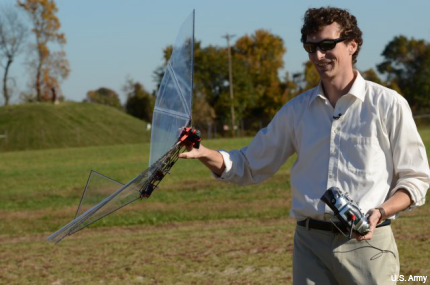Robo Raven: A drone that actually does fly like a bird
ARL is developing an unmanned system with flexible, flappable wings that could do things other UAS can't.

Gerdes prepares to turn Robo Raven loose during tests earlier this month.
Army researchers are working on developing a small unmanned aerial system that flies like a bird—a well-trained bird, in fact.
During tests earlier this month at the Spesutie Island Robotics Research Facility on Chesapeake Bay in Maryland, John W. Gerdes III, a mechanical engineer at the Army Research Laboratory’s Vehicle Technology Directorate, held the half-pound “bird,” called Robo Raven, in his hand, turned on a transmitter, and sent it flapping into the sky. After executing some maneuvers and adjusting its flight for wind, the Robo Raven drew the attention of a raptor (maybe a hawk) Gerdes decided to bring it in, with the UAS alighting on his raised hand, just like a trained falcon would return to its master.
The research is part of ARL’s efforts to explore the possibilities—and intricacies—of bird-like flight for UAS, the Army said in a release. Among the potential advantages would be combining the hovering ability of, say, a rotocraft with the speed of a conventionally designed plane. A flapping UAS could also be quieter and less likely to draw visual attention.
But the project still has a long way to go. Engineering a machine to mimic the flight of birds, which is controlled by countless nerves, muscles and subtle, instantaneous adjustments to airflow, obstacles and other flying objects, is a complex problem. "It's extraordinarily difficult to unravel all of the pieces of that problem," even with flexible wings, sensors and a variety of controls, Gerdes said. "It's just too difficult to engineer at this point. But, we can approach that solution at least."
RoboRaven, which is being designed in conjunction with the University of Maryland, at the moment is a combinations of cutting edge technology and everyday tools. Its flexible, lightweight components are designed and created with the help of ARL’s 3D printer. In the above video, Gerdes notes that they couldn’t be made any other way. But the flapping motion is controlled by a commercial Arduino micro-controller (albeit specially programmed by Gerdes) and the transmitter is the same kind used for hobbyist drones and toy vehicles, the Army said.
While the project is showing a lot of promise, things don’t always go perfectly. In three recent flight tests, Robo Raven twice successfully returned to land on Gerdes’ hand, but in the other it crashed into the grass. Wind also is a big factor for the device, which because of it actually flies more like a butterfly than a bird, the Army said. And there is the challenge of what to do about birds. Raptors like hawks and falcons have been known to attack Robo Ravens, and even non-predators are attracted to it.
But the main purpose right now if to study the dynamics of this kind of flight. "It's our goal to build the most amount of knowledge about flapping-wing air vehicles as possible," Gerdes said.
Next up, the research team plans to add a suite of sensors that can measure factors such as altitude, air speed, wing position, flapping speed, power draw, acceleration, and others. And eventually, they would like to develop a new flexible material that could make bird-like flight more possible.
The video below, from the University of Maryland, offers more footage of Robo Raven in action.
NEXT STORY: Army awards $662M deal for new recon aircraft




